Kenneth L. Gentry Jr.'s Blog, page 49
January 29, 2021
THE CONQUERING CHRIST AND THE MILLENNIUM
 PMW 2021-009 by Milton S. Terry
PMW 2021-009 by Milton S. Terry
Milton Terry (1840–1914) has many valuable insights into the Book of Revelation, some of which highlight his postmillennialism. In this and the next few articles, I will be highlighting some of these. Interestingly, though he rightly notes Revelation’s focus on first-century events, he also recognizes a few brief glances into the distant future (as do I!).
I will be citing the Revelation commentary section of his Biblical Apocalyptics as providing interesting and important insights for postmillennialists. Once it is introduced, all of the following material will be a direct citation from his book, although I have broken it into smaller paragraphs. Older writers (from the nineteenth and early twentieth centuries) apparently saw no need for a paragraph ever to end! And writers even older than Terry, such as John Gill (1697–1771), saw no need for a sentence to end — especially since they enjoyed the use of the semi-colon. Fortunately, they did not follow first century practice of not even having spacing between words so that a word itself would never end!
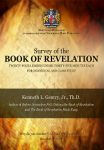
Survey of the Book of Revelation
(DVDs by Ken Gentry)
Twenty-four careful, down-to-earth lectures provide a basic introduction to and survey of the entire Book of Revelation. Professionally produced lectures of 30-35 minutes length.
See more study materials at: www.KennethGentry.com
But now, let us listen to Terry’s commentary on Revelation (Biblical Apocalyptics, p. 443):
THE MILLENNIAL CONFLICT AND TRIUMPH. 19:11–21:8
In this section of the book we have a series of seven visions, each beginning with the words kai eidon, “and I saw.” It opens with the picture of a heavenly Conqueror going forth, in company with white-robed armies, to smite the nations with the sword of his mouth and after a series of wonderful victories it concludes with the picture of a new heaven and a new earth, from which all evil-doers are cast out. From the seer’s point of view it is an apocalyptic outlook into the Messianic era, the millennial age, during which “the law shall go forth out of Zion and the word of Jehovah from Jerusalem” (Micah 4:2; Isaiah 2:3).
While disclosing an ideal outline of future Messianic triumphs the prophet does not transcend the main purpose of his book, which is “to show the things which must shortly come to pass” (1:1). That purpose is accomplished when he depicts the overthrow of Judaism, the end of the old temple dispensation and the consequent opening of the new era, the Messianic age, which is destined, according to the prophets, to make all things new. His task is complete when he shows forth the beginning of the new age and a visional outline of what that age will bring.
He furnishes no “continuous historical” record of the progress of Christianity in the Roman empire. We should no more look in the prophecies of this book for a syllabus of the petty feuds of mediæval Europe than for an account of modern missions in India, China and Japan. Too long have false presumptions led men to search in apocalyptic pictures for predictions of such events as the French Revolution, the fall of Napoleon Bonaparte, the Protestant Reformation and the Wars of the Roses. One might as well expect to find in scripture predictions of the discovery of America and the invention of the steam engine and the electric telegraph. The mind that gives itself to discover such things in biblical prophecy misapprehends the mind of the Spirit. The fallacy of such procedures in exegesis lies in a total misconception of the nature and scope of apocalyptic writing.
[Biblical Apocalyptics, p.444]
19:11. I saw the heaven opened — Compare the language of Ezekiel 1:1. We are about to have a new apocalyptic picture of the Son of man coming in the clouds of heaven (1:7), but it is the picture of an æonic struggle upon which he sets out, not a single historical event to which one can point and say, Lo here! or, Lo there!
The Book of Revelation Made Easy
(by Ken Gentry)
Helpful introduction to Revelation presenting keys for interpreting. Also provides studies of basic issues in Revelation’s story-line.|
See more study materials at: www.KennethGentry.com
A white horse — The symbol of victorious procession here as in 6:2, but he that sat thereon is not the same as the rider on the white horse in the earlier vision. His title of faithful and true is sufficient to designate him as the Christ of 1:5 and 3:14 and the additional statement that in righteousness he judges and makes war, appropriated from Psalm 96:13; Isaiah 32:1; Jeremiah 23:5,6, shows that he is no other than the Messiah of Old Testament prophecy.
[Biblical Apocalyptics, p. 445]
The foregoing vision (verses 11–16) is a most sublime apocalypse of the conquering Messiah, who “must reign until he has put all his enemies under his feet” (1 Corinthians 15:25). The struggle may consume a million years. The details and chronology of its age-long history no prophet has foretold, but this unrivaled portraiture presents the conquering King, with his names, his insignia and his works.
January 26, 2021
THE MARRIAGE SUPPER OF THE LAMB
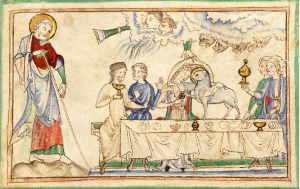 PMW 2021-008 by Kenneth L. Gentry, Jr. (with Milton S. Terry)
PMW 2021-008 by Kenneth L. Gentry, Jr. (with Milton S. Terry)
The New Testament has many images of the glory of Christ’s kingdom and our joyous salvation in it. One of the most glorious images is that of a joyful marriage supper. Though this image appears directly in several New Testament passages (e.g., Matt. 22:2ff; 25:2ff) and indirectly in others, one of the most impressive presentations is in the Book of Revelation.
Milton Terry on the Supper
In his Biblical Apocalyptics (p. 441), Milton S. Terry comments on the marriage supper of the Lamb as presented in Revelation:
In [Revelation 19:9] below mention is made of “the supper of the marriage of the Lamb.” The song being cast in a prophetic mold, things future are conceived as already complete and hence the aorists of this verse, “came” (elthen)) and “made ready” (hetoimasen). The marriage of the Lamb is the union of Christ with believers and is therefore essentially a fact of spiritual life.
The feast or supper of that marriage is a figure for the delightful fellowship, the blessed entertainment and fruition of such vital union with the Prince of life. The marriage of the Lamb is a process continually going on as long as such unions of Christ and his beloved and elect ones continue to be consummated. The glory and blessedness of life with Christ in heaven are but the perpetuation of the union formed by faith and love in this world.
The marriage and feast of this apocalyptic song are accordingly to be understood as referring to the same spiritual fact as the parables of the marriage of the king’s son in Matthew 22:2–13 and the great supper in Luke 14:15–24.
“His wife hath made herself ready” — In apocalypse as in parable facts or great truths which continue for ages are necessarily pictured in harmony with the figure employed. The union of one believer with Christ is a representative of all such unions of all time. But to conserve the figure of a marriage feast the entire process of ages is conceived as complete.
Three Views on the Millennium and Beyond
(ed. by Darrell Bock)
Presents three views on the millennium: progressive dispensationalist, amillennialist, and reconstructionist postmillennialist viewpoints. Includes separate responses to each view. Ken Gentry provides the postmillennial contribution.
See more study materials at: www.KennethGentry.com
Gentry comments
Terry well captures an important truth regarding the marriage supper which is missed by too many. The marriage supper is neither a one-time event at the beginning of Christian history nor an event punctuating the end of Christian history and the introduction of the final eternal estate. Rather it is an image of the ongoing calling and saving of sinners which brings them into the joyous continuing celebration of union with Christ.
Thus, the marriage supper began in the first century and continues until the last day. As Terry puts it: “The marriage of the Lamb is a process continually going on as long as such unions of Christ and his beloved and elect ones continue to be consummated.” And: it will “continue for ages.”
The marriage of the Lamb necessarily includes all the saints of God. Therefore, the marriage supper cannot be a completed event, for men and women are continually being saved and brought into union with Christ. And the ongoing joy of the Christian life is well captured by the picture of a wondrous celebration of that life in union with Christ.
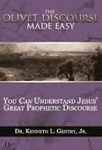
Olivet Discourse Made Easy (by Ken Gentry)
Verse-by-verse analysis of Christ’s teaching on Jerusalem’s destruction in Matt 24. Shows the great tribulation is past, having occurred in AD 70, and is distinct from the Second Advent at the end of history.
See more study materials at: www.KennethGentry.com
Tragically, the Jewish nation rejected Christ and God’s gracious invitation to enter into the supper (Matt. 22:1–6) and were judged because of that (Matt. 22:7). Yet, God has sent out messengers to continually gather us in (Matt. 22:8–10), though only those who have truly readied themselves (i.e., been truly converted by God’s grace) will be accepted (Matt. 22:11–14). This ongoing mission is directed by the Great Commission, which engages “all nations” until the end comes.
January 22, 2021
THE VALUE OF CREEDS
 PMW 2021-007 by By W. Robert Godfrey (Wesminster Seminary California)
PMW 2021-007 by By W. Robert Godfrey (Wesminster Seminary California)
Imagine a Christian gathering in Alexandria on the night before Easter, 173. A young man who has heard the Gospel message of Jesus Christ is ready to be baptized. He has received some instruction in the faith and has brought his life into conformity with Christian ethics. He stands clothed in white with others near the water for baptism. The bishop and presbyters approach and ask him what he believes. He recites a brief summary of the faith that he has memorized. Others about to be baptized recite the same summary. This summary used by those about to be baptized was written by the bishop himself some years earlier to help prepare new believers for baptism.
The summary grew out of the bishop’s sensitive response to Paul’s warning that from the very heart of the church would arise some who would proclaim a false gospel: “I know that after I leave, savage wolves will come in among you and will not spare the flock. Even from your own number men will arise and distort the truth in order to draw away disciples after them” (Acts 20:29-30). The bishop knew that he was an overseer and a shepherd over a part of God’s flock and saw his responsibility to preserve the sheep entrusted to him. He saw the dangers that surrounded the sheep.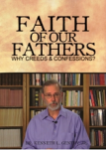
Faith of Our Fathers (DVDs by Ken Gentry)
Explains the point of creeds for those not familiar with their rationale.
Also defends their biblical warrant and practical usefulness for defending historic, Christian orthodoxy in our heterodox world.
See more study materials at: www.KennethGentry.com
The obvious danger to the flock was the pagan world that not only denied the truth of Jesus the Savior but persecuted His followers. But there were other less obvious dangers as well – dangers from those who claimed to be Christians but taught false doctrines. Some said Jesus had not really been a man with a physical body. Some said Jesus was only a man on whom the Spirit of God had come with unusual power. Many other heresies were taught. Some of the false teachers had organized their followers into churches that they proclaimed were the true churches of Jesus Christ.
The bishop recognized his responsibility to protect the people and the truth from these false teachers. Again he was inspired by the words of Paul, “What you heard from me, keep as the pattern of sound teaching, with faith and love in Christ Jesus” (2Timothy 1:13). The bishop drew up a brief pattern or “form of teaching” (Romans 6:17) specifically to summarize true Christian teaching in a way that would not only affirm the truth, but do it in such a clear way that followers of false teaching could not use it. This summary was then given to candidates for baptism as part of their instruction in the faith. The summary helped define the faith more clearly for the new believer, protected the faith from false teaching, and provided a testimony to the world as to the truth of Christian belief.
The bishop in 173 is imaginary and his precise line of thought is conjecture. But in the second century it is certain that local church leaders began to write brief summaries of the faith to use with candidates for baptism. These summaries are the earliest evidence for the emergence of creeds in the life of the church. (The word creed comes from the Latin word credo, which literally means “I believe” and was the first word in Latin creeds.) These creeds were designed to define the faith, protect the faithful, and testify to the world what the church believed.
In time the creeds moved from being related to the baptismal service to becoming a part of the regular worship service. The whole congregation was united in reciting the creed to express its common faith. Initially local churches developed their own creeds. But gradually they began to show their unity with other orthodox churches by moving toward a common creed. Today among evangelicals the most familiar creed is the Apostles’ Creed. Elements in that creed probably go back to those baptismal creeds of the second century, although the Apostles’ Creed did not become the most used creed in the Western churches until the ninth century.
 Christ’s Church (20 mp3 downloads)
Christ’s Church (20 mp3 downloads)
by Ken Gentry
An in-depth sermonic presentation of the doctrine of the church. This is vitally important today with the evangelical church not living up to its biblical calling
See more study materials at: www.KennethGentry.com
The Apostles’ Creed is basically Trinitarian, confessing the persons and work of the Godhead. The Creed confesses the Father in His creating work, the Son as incarnate Savior, and the Holy Spirit as the One who applies the work of Christ to gather the church and bring salvation.
The most celebrated creed written in the first 500 years of the church was the Nicene Creed. This creed was . . . . To finish reading this article click: The Value of Creeds
January 18, 2021
THE SEEDS OF CREEDS
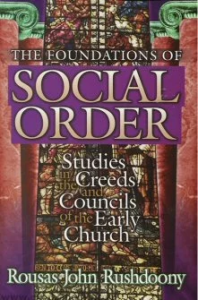 PMW 2021-006 by Kenneth L. Gentry, Jr., Th.D.
PMW 2021-006 by Kenneth L. Gentry, Jr., Th.D.
Though they are not on a par with Scripture itself, the ecumenical creeds are important instruments for securing, promoting, and defending the Christian faith. They are designed to secure the faith by outlining the broad doctrinal borders of true Christianity by defining the basics of what historic Christianity believes. They promote the faith by succinctly summarizing it so that the whole Bible does not have to be read and explained in order to present the gospel of salvation to unbelievers. They defend the Christian faith by exposing corruption entering into some of its basic biblical doctrines by means of confusion or heresy.
On a smaller scale, church confessions (such as the Westminster Confession of Faith) secure, promote, and defend the basics of Presbyterianism. Church confessions outline the distinctives of a particular body of Christians, whereas the ecumencial creeds outline the distinctives of the Christian faith as a particular worldview among men.
The concept of creeds arise in Scripture itself. Certainly no law in Scripture explicitly commands “Thou shalt frame creeds.” Nevertheless, the impetus and mandate for creeds derives from good and necessary inferences deduced from Scripture.
We can demonstrate this in a variety of ways, three of which will suffice for our present purpose.
First, the biblical call for a public affirmation of faith
The call for a public affirmation of faithserves as the prime impetus to creedalism.
The essence of Christian duty is to be a witness (Acts 1:8). This requires publicly defining the exact identity of that to which the Christian is witness. Obviously reciting the entire Scripture record at a given opportunity of witness is not possible. Furthermore, only God can look into the hearts of individuals to ascertain their innermost faith (1 Sam. 16:7; Luke 16:15). Thus, for others to know of an individual’s personal faith it is necessary to put it into words. “With the heart man believes, resulting in righteousness, and with the mouth he confesses, resulting in salvation” (Rom. 10:10). Hence, the necessity of a creed in defining the content of belief.
Lord of the Saved
(by Ken Gentry)
A critique of easy believism and affirmation of Lordship salvation. Shows the necessity of true, repentant faith to salvation.
See more study materials at: www.KennethGentry.com
Second, mini-creeds are found in Scripture
Mini-creeds are preserved in the biblical record of apostolic Christianity itself.
The very seeds of a full-blown creedalism are sown in the apostolic era via terse statements of faith which are widely employed. Perhaps the most familiar of these rudimentary creeds is the recurring one embedded in such texts as Acts 10:36; Romans 10:9; 1 Corinthians 12:3; and Philippians 2:11: “Jesus is Lord.” This eminently important statement embodies — “encreeds,” if you will — a particular way of viewing Jesus Christ. It is fundamentally necessary to hold as one’s credo: “I believe Jesus is Lord.”
Third,the apostolic church used creeds
Within the biblical record we find early ecclesiastical assemblies re-casting already known truths to ensure their accurate preservation and transmission.
Acts 15 is the locus classicus in this regard. There the Church restates “justification by faith” in response to a Christian-Pharisaic pressure demanding the circumcision of Gentile converts (cf. Acts 15:1).
After noting several such situations in Scripture, nineteenth-century Scottish Presbyterian theologian James Bannerman observes:
“Such, within the age of inspiration itself, are the remarkable examples we have of the necessity, growing out of the circumstances of the Church and its members, that arose at different times for recasting the doctrines of Scripture in a new mold, and exhibiting or explaining it afresh under forms of language and expression more precisely fitted to meet and counteract the error of the times.”
Thus the concept of creedalism is a Scriptural one that in no way diminishes the authority of Scripture or implies its inadequacy.
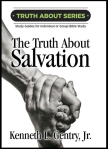 The Truth about Salvation By Ken Gentry
The Truth about Salvation By Ken Gentry
A study guide for personal or small group Bible study. Deals with the Christian doctrine of salvation from a Reformed theological perspective. It opens with a study of God as loving Creator, the shows how the first man fell into sin. Shows God’s righteousness requires that sin be dealt with. Presents Jesus as both God and man so that he can be man’s Savior. Includes review questions and questions for further study.Twelve chapters are ideal for one quarter of Sunday School.
See more study materials at: www.KennethGentry.com
January 15, 2021
FIGURES OF SPEECH IN SCRIPTURE
PMW 2021-005 by Ardel B. Caneday
“The Importance of Recognizing Figures of Speech in Scripture”
I had intended to post an article that would flow out from the one last week. However, my rather lengthy response to a friend’s question addresses an issue from which I believe others will benefit. The query raised was generated out of the inquisitor’s hearing my four lectures a few weeks ago at the Common Slaves Fall Conference where my theme was “Let Us Run the Race with Perseverance and Assurance.”
I think that I understand your concern. As I read your correspondence, the following statement leaps out to me: “In any case, I feel funny about it because it seems I’ve been trained to view the cross as the only thing in life or death worth really focusing on, or as the old line goes, beat a path to the cross since everything flows that direction.” I think that the issue that nags at you is the same one that I observed many years ago while listening to a sermon by a preacher whose fame was on the rise. I distinctly remember that while I sat and listened to that sermon I was frustrated with what struck me as needless obscuring of what should have been clear to anyone who occupies the pulpit and which the preacher should have made clear with relative ease if he had given sufficient attention to how the Apostle Paul expresses his thoughts. Some preachers, however, seem to have an uncanny knack for rendering biblical texts unduly complex and complicated.

Getting the Message
(by Daniel Doriani)
For all those who fear that the Bible is a mysterious labyrinth through which they cannot find their way, Doriani provides wonderful guidance. Written with craft and wit, this highly readable book combines great biblical insight with marvelous practical wisdom.
See more study materials at: www.KennethGentry.com
The preacher was preaching on Galatians 6:14—“May it never be that I would boast except in the cross of our Lord Jesus Christ through which the world has been crucified to me, and I to the world.” What troubled the preacher is the exclusivity of the cross as the only thing in which the Apostle Paul would boast, yet elsewhere the Apostle seems to be boasting in other things. He was troubled by other texts where Paul uses the same word for “boast” or “exult” to speak of boasting or exulting in other things. He cited the following passages as sources of his disquiet.
We exult in hope of the glory of God (Romans 5:2).
We also exult in our tribulations, knowing that they produce patience and approvedness and hope (Romans 5:3).
Most gladly, therefore, I will rather boast about my weaknesses (2 Corinthians 12:9).
Who is our hope or joy or crown of exultation? Is it not even you?” (1 Thessalonians 2:19).
Thus, the preacher wondered, “So, if the Apostle can boast and exult in all these things, what does he mean when he claims that his exclusive boast is in the cross of our Lord Jesus Christ? Does Paul engage in double-talk? Is he contradicting himself by saying that he is exulting only in one thing but also exulting in other things?”
As I reflect on that sermon, it took many needless minutes for the preacher to reach some resolution of the tension, and yet, his resolution was neither sufficient nor satisfying as he presented it. Yes, he eventually did make the point that all our boasting or exulting should be exultation in the cross of Christ by affirming that exulting in the hope of God’s glory, exulting in tribulations, exulting in weaknesses, etc. should be an exulting in the cross. Why was it not sufficient or satisfying? The answer troubled me immensely as I listened to the sermon and it still troubles me because I heard him preach the same sermon on another occasion. That subsequent sermon showed that the preacher still did not understand the point that I am about to make. While I sat there in the pew listening intently to the sermon, I thought, “How is it that a highly educated preacher does not seem to grasp the literary nature of what the Apostle Paul wrote to the Galatians? How is it that a seminary educated preacher fails to apprehend the figure of speech that the Apostle Paul is using in Galatians 6:14? How simply and how clearly the preacher could have answered his own puzzlement and question and resolved the tension if he had simply assisted the pew people to understand that Paul is using a figure of speech in the passage, that Paul uses synecdoche when he mentions the cross of Jesus Christ just as he does elsewhere. How simple and clear it would be if only he would show the people that Paul uses ‘the cross’ as a principal aspect of the gospel by way of synecdoche for the gospel.”

As It Is Written: The Genesis Account Literal or Literary?
Book by Ken Gentry
Presents the exegetical evidence for Six-day Creation and against the Framework Hypothesis. Strong presentation and rebuttal to the Framework Hypothesis, while demonstrating and defending the Six-day Creation interpretation.
See more study materials at: www.KennethGentry.com
Galatians 6:14 is not the only place where Paul uses “the cross” as an aspect of the gospel by way of synecdoche for the whole gospel (synecdoche—a part used to represent the whole). Even more vividly Paul synecdoche in 1 Corinthians 1:17-18—“For Christ did not send me to baptize, but to preach the gospel—not with wisdom and eloquence, lest the cross of Christ be emptied of its power. For the message of the cross is foolishness to those who are perishing, but to us who are being saved it is the power of God.” Here, it is obvious that Paul substitutes “the gospel” with “the cross of Christ,” by way of synecdoche, when he mentions the cross again, he expands it to “the message of the cross.”
Without any doubt, the preacher eventually got it right in his sermon concerning why our boast must be in the cross of Christ. The reason is that everything, whether good or bad (for in God’s purposes all things work together for our good for all who are in Christ Jesus) was secured by the cross of Christ Jesus. Without his crucifixion, every one of us would receive nothing but divine punishment. Without the cross, ours would be only condemnation. Consequently, everything that we enjoy in Christ is due to the cross. Apart from the cross, there is no blessing at all.
Therefore, I am arguing that the conflict you are experiencing, as expressed in the statement I cite above, is no real conflict at all. Your own comment captures this well when you query, “Maybe it’s best thought of as a mental shift from cruci-centricity to a more fully-orbed Christocentricity?” My response to your query is this: To be cruci-centric is to be Christo-centric. Why? Because any proper featuring of the cross is not essentially a crucifix, the cross with Christ Jesus still on it. Rather, any proper featuring of the cross necessarily entails synecdoche, as the Apostle Paul conceives of the gospel, by featuring a principal aspect of Christ’s work, namely his sacrificial death on the cross, for the whole of Christ’s work. It is to feature an aspect of the gospel as a representative of the whole gospel. Any proper mention of the cross of Christ necessarily points to God’s Last Day verdict brought forward into the midst of history by Christ Jesus who brought forward both the verdict of God’s judgment and the vindicating life of resurrection from the Last Day. Thus, when Christ Jesus was crucified, he endured the wrath of God’s Last Day judgment on behalf of everyone who is in him. Likewise, when he was raised from the dead, his resurrection assured that all who are in him will most certainly rise from the dead unto eternal life on the Last Day, the Day Resurrection.
Thus, our prospective gaze upon Christ Jesus that we might lay hold of (Philippians 3:12-14) does not in the slightest diminish our cruci-centric affirmation. Rather . . . .
To finish reading the article, go to Ardel B. Caneday’s blogsite
January 11, 2021
TOWARD A BIBLICAL OPTIMISM
 PMW 2021-005 by Timothy M. Kucij
PMW 2021-005 by Timothy M. Kucij
At the time of our marriage, many years ago, my wife and I made some promises to ourselves, each other, and to God. One of these promises was that we would read the Scriptures daily in a devotional setting. As we focused on the general tenure of Scripture it became evident that here was an optimistic book. Christ is pictured throughout as the conquering Savior with a promise of the ultimate triumph of His people and His kingdom on earth in this age.
Most of the outstanding characters of the Bible reflected this optimism, even in the darkest of times. In Noah’s day the earth was filled with violence and wickedness. Noah was commissioned by God to build an ark to save the human race and certain animals from impending disaster. It must be remembered that he was surrounded by a mass of godless unbelievers who would come and see his work, attracted by curiosity, and no doubt remain to scoff at him. Still his faith remained. He preached a positive message of victory from disaster.
Similarly, Joshua was a man who maintained unwavering faith in the most adverse times. He was one of twelve spies sent from Kadesh to view the land of Canaan. And while most of the spies lost faith, gave up hope, and issued a negative report, Joshua (along with Caleb) was firm in his faith and message of victory and triumph. Elijah too is an example of a man who faced a mass of doomsayers and false religionists, but stood firm in his convictions that God would give victory and triumph.
In the New Testament, Paul proclaims the conversion of the Jews through the agency of the gentile Gospel (Rom. 11:26-31). He envisions an exalted Christ who is King and Head “over all things” on behalf of the church (Eph. 1:19-23). Then he reaches a crescendo of triumphant praise concerning “the exceeding greatness of his power to us-ward who believe, according to the working of his mighty power” as He leads us in the assault upon the powers and principalities.
Finally, the book of Revelation thematically portrays the conflict of the ages ending in ultimate triumph, paradise regained, and a new heaven and earth after a millennium of triumph for his saints on this earth.
Certainly, the Bible paints a message of hope and victory for the saints of God. But it has been my experience, by attending various churches and through reading literature, that the message which pervades Christendom today is not the same optimistic message of hope and victory portrayed in Scripture. Rather there seems to be a negative message of despair and gloom. In part this is due to the prevailing eschatology of our day. The church is seen as a loser. Christians are admonished to snatch a few for the kingdom before Christ comes in the clouds to “rescue” His church. The following statement by Klaas Runia in Christianity Today (June 19, 1970), page 13, illustrates this point:
“Why is there such a pessimistic vein in many sectors of evangelical Christianity? Is it because most of us are amillenarians or premillenarians? Is it because we expect the world to grow worse and believe we can do very little about it, apart from praying for the return of our Lord?”
Now when I first entered the ministry, I too held this view of eschatology. But as time went on and I dug deeper into the Word, I realized that this view was at odds with the scope and tenure of the message of the Bible. The prevailing eschatology teaches that the church age is only a “parenthesis” in God’s program for the Jews; if so, then certainly the centrality and importance of the House of God (church) is minimized. But Jesus said, “I will build my church; and the gates of hell shall not prevail against it.” The New Testament sees the church on the offensive and ultimately in a victorious posture. Jesus commissioned His church to evangelize the world before He returns: “And this gospel of the kingdom shall be preached in all the world for a witness unto all nations: and then shall the end come” (Matt. 24:14).
As I have read various periodicals and attended numerous churches I am distressed to hear this message of gloom which is so at odds with the Bible’s positive, spiritually edifying, optimistic message of hope for the success of the churches on earth (see Isa. 2:1-5; 11:9; Eph. 3:10, 11). In contrast, the pervasive message today is really one of defeat and despair for the church in its role of witness to all the earth, while the message of Scripture is one of hope and victory (Acts 1:8).
Part of the fuel for the great awakenings in former centuries was the eschatology of the “latter day glory” then embraced. Under this influence in the mid-eighteenth century, for example:
“a number of worthy characters ran to and fro, through the eastern states, warmly exhorting to the prompt adoption of every measure tending to hasten that blissful period . . . One, and not the least sanguine, of these pious missionaries, was my venerable father . . . [whose] most sanguine expectation must have, so far, been fully realized” (Lives of Virginia Baptist Ministers, by James B. Taylor).
What a stimulus for preaching, and what success they had!
Calvin and Culture: Exploring a Worldview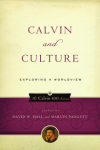
Ed. by David Hall
No other Christian teachings in the past five hundred years have affected our Western culture as deeply as the worldview of John Calvin. It extends far beyond the theological disciplines.
See more study materials at: www.KennethGentry.com
The solution to this disparity is to not only reassess our eschatology in light of direct biblical teaching, but in all things to “be perfectly joined together in the same mind and in the same judgment” (I Corinthians 1:10). The road to such a phenomenon is not easy. Individuals and individual churches must be lowly and meek in spirit (Ephesians 4:1-3) in order to come to a sameness of mind and judgment, with the same doctrine, principles, goals, concerns and vision. We have a mutual mission; we should optimistically anticipate a mutual victory!
 Tim M. Kucij lives in Claremont, California, and has served as pastor and on staff at a number of churches through the years. He is a reformed, postmillennial Baptist. He is also a well known composer-arranger-pianist. He writes for the glory of God on Bach’s principle that all music should glorify God. His latest CD is “Kaleidoscope.” You may order his CDs from Amazon. His website is: timkucij.com
Tim M. Kucij lives in Claremont, California, and has served as pastor and on staff at a number of churches through the years. He is a reformed, postmillennial Baptist. He is also a well known composer-arranger-pianist. He writes for the glory of God on Bach’s principle that all music should glorify God. His latest CD is “Kaleidoscope.” You may order his CDs from Amazon. His website is: timkucij.com
January 8, 2021
PROTOLOGY & ESCHATOLOGY (4)
 PMW 2021-003 by Kenneth L. Gentry, Jr.
PMW 2021-003 by Kenneth L. Gentry, Jr.
I am returning to my analysis of the Framework Hypothesis which overthrows the long-held traditional interpretation of Gen 1 by changing the clear message of the creation narrative in Genesis 1. As noted previously, this is significant for the postmillennialist in that the postmillennial argument literally begins “In the beginning.”
In the two previous articles I quickly presented and briefly rebutted the first two arguments for the Framework view: (1) The triad of days (i.e., the framework) in Genesis 1. (2) The new interpretation of Gen 2:5 which allegedly presents God’s modus operandi in creation week (i.e., slow providence rather than instant miracle). In this article we come to the final theological argument for the Framework Hypothesis that Meredith Kline and his disciples employ: the two-register cosmogony.
The two-register cosmogony explained
Meredith Kline not only created the new and innovative providence argument based on Gen 2:5, but later developed an all-new and rather complicated final argument for the Framework Hypothesis. Kline deems the two-register cosmogony to be the umbrella argument that covers the triad and providence arguments.
By this “two-register” idea Kline is speaking of the upper register (the realm of God’s special presence, heaven) and the lower register (the realm of man’s habitation, the cosmos). He argues that Genesis 1 speaks sometimes of the upper register and sometimes of the lower register,; and he argues that we must recognize where the shifts of thought occur.
Election and Free Will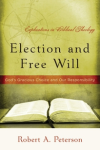
by Robert A. Peterson
Election and Free Will helps Christians who believe in a Reformed view of predestination to better understand their faith. Robert A. Peterson traces Scripture’s teaching on election through the Bible and explains the doctrine of free will. He also tackles objections to predestination and concludes with applications of this neglected biblical teaching.
See more study materials at: www.KennethGentry.com
Particularly significant for the Six-day Creation view, Kline declares that the “days” of Genesis 1 belong to the upper register. They are a part of the analogical relationship between the upper and lower registers. The days are therefore not to be understood as literal, lower register time-frames, but as metaphors that use man’s work week to symbolically portray God’s work “week.”
Kline presents a few reasons for his creation (!) of this new approach (which makes his view a “new creation,” apparently!). Underscoring the supposition that Moses is speaking metaphorically are subtle evidences from the text. I will mention two of those.
First, the revelation of God’s creation of Adam employs anthropomorphism. It speaks of God’s work by employing the metaphor of a potter: “Then the LORD God formed man of dust from the ground, and breathed into his nostrils the breath of life; and man became a living being” (Gen 2:7). Clearly God did not literally use a potter’s wheel for creating Adam, this is an anthropomorphism (using things that belong to man [anthropos] and applying them to God).
Second, God “rests” on the seventh day: “God blessed the seventh day and sanctified it, because in it He rested from all His work which God had created and made” (Gen 2:3). This is another anthropomorphism which presents something that man would need to do, not God. It is applied metaphorically from man’s experience in the lower register to God in the upper register.
The two-register cosmogony critiqued
Two main problems undercut Kline’s argument that the days of creation are metaphors speaking of God’s upper register work: First, this idea contradicts the clear and express meaning of Exodus 20:11: “six days you shall labor and do all your work. . . for in six days the Lord made the heavens and the earth.” This informs us that man’s week is rooted in God’s original creation. Kline’s view has the matter exactly backwards of what God says.
Second, Kline uses anthropomorphisms in a new and unique way. Historically, anthropomorphism applies features of man’s being to God’s being, i.e., features of man’s body to God who does not have a body. We see this when Scripture speaks of the arm of the Lord, or the eyes of the Lord, and so forth.
And even beyond these major problems, we find that Kline really does not interpret these Genesis texts and images properly when he analyzes them. For instance, when God “formed” Adam’s body, Moses does not mention anything such as God using his “arms” and “back” in digging up the soil for this special project — though he can speak of God’s redemptive activity by using “arm” imagery elsewhere (Exo. 6:6; 15:16; Deut. 4:34; 5:15). Nor do we discover a reference to the Lord’s “hands” and “fingers” carefully sculpting Adam’s body, as in the metaphorical potter imagery found in the prophets (Isa. 45:9; 64:8; Jer. 18:4-6; Lam. 4:2). Genesis 2 presents a bold, supernatural event in unadorned, factual form: God formed Adam’s body from the ground — without detailing how he did it.
Thus, anthropomorphism is actually avoided in this revelation of the historical fact of God’s creative activity. Furthermore, over against any alleged anthropomorphic imagery in Genesis 2:7, we learn that Adam’s body was formed from the dry “dust from the ground” — not “clay” as employed in the familiar potter’s art in Israel (cf. Isa. 29:16; 41:25; 45:9; Jer. 18:4, 6). Even Genesis commentator Victor Hamilton observes of the verb Moses employs: “‘Potter,’ however, is a suitable translation only when the context clearly points to the fact that the work of formation being described is that of a potter.”
Bringing Heaven Down to Earth
(by Nathan Bierma)
A Reformed study of heaven. By taking a new look at the biblical picture of heaven,
Nathan Bierma shows readers how heaven can be a relevant, meaningful,
inspiring engine of Christian faith and kingdom service.
See more study materials at: www.KennethGentry.com
Also regarding the word “rest” found in Gen 2:2–3: neither is this an anthropomorphism. After all, the text of Gen 2:2-3 does not speak anthropomorphically of God “resting,” as if relaxing. It actually informs us that God “ceased” his labor. As Genesis commentator Kenneth Mathews observes: “The verb translated ‘rested’ here means ‘the cessation of creative activity’; it has this same sense in its only other occurrence in Genesis, where God promises the postdiluvian world that the times and seasons ‘will never cease’ (8:22).”
Elsewhere we find that God ‘rested’ (nûah, Exod 20:11; napaš, 31:17), but here in Gen 2 the passage speaks of the absence of work — ‘he abstained’ from work.” That is, God did not relax as if from weariness (as does man); he simply ceased from his creating work (creation week is over).
Actually the text is even stronger, for as Umberto Cassuto puts it: “this verb has been translated or interpreted by many as if it signified ‘to rest’ or ‘to cease work’; but this is incorrect. It has a negative connotation: ‘not to do work.’” And most certainly it is literally true that God ceased his creative working. Though it was not a laborious chore for him, it was most definitely “work” that effected something — the universe.
Thus, Kline’s new argument that Gen 2 involves anthropomorphism that allows us to read anthropomorphism into the creation days of Gen 1 fails. The majestic march of days in Gen 1 are clearly literal, successive, chronological days of creation week which serve as the basis for man’s work week.
January 4, 2021
PROTOLOGY & ESCHATOLOGY (3)
 PMW-2021-002 by Kenneth L. Gentry, Jr.
PMW-2021-002 by Kenneth L. Gentry, Jr.
As I have been noting in this series: creation and consummation are theologically-linked in Scripture. Therefore, a proper view of creation is significant for the eschatological argument for postmillennialism. Simply put: if you do not begin right, you will not end right. Therefore, when I present a full argument for postmillennialism, I begin with creation.
Not only am I a postmillennialist, but I am also a Six-day Creationist, hence a non-evolutionist.
In this series I am defending Six-day Creation against the Framework Hypothesis by demonstrating the Framework’s errors. This hypothesis is as a major evangelical opponent of Six-day Creation, and not surprisingly, is held mainly by amillennialists.
I am drawing the material for this series from my recently released book, As It Is Written: The Genesis Account: Literal or Literary? In that book you will find a thorough analysis of the issues that I can only summarize here. In the previous article I highlighted the triad of days argument which gives the “Framework” Hypothesis its name: the triad presents the framework that Moses used for presenting the fact of creation. In this article I will present a second major argument for this theistic-evolutionary interpretation of Genesis 1–2.
The providence argument
In Genesis 2:5 we read:
“Now no shrub of the field was yet in the earth, and no plant of the field had yet sprouted, for the Lord God had not sent rain upon the earth; and there was no man to cultivate the ground.”
In 1957 Old Testament theologian Meredith Kline developed this verse into an argument supporting the Framework Hypothesis. He holds that this verse establishes God’s mode of operation during the creation week which shows that he used slow providence rather than instantaneous miracle.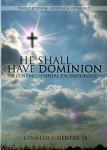
He Shall Have Dominion
(paperback by Kenneth Gentry)
A classic, thorough explanation and defense of postmillennialism (600+ pages). Complete with several chapters answering specific objections.
See more study materials at: www.KennethGentry.com
Kline argues that this verse speaks of “day” three of creation when God created plant life. He sees this verse as suggesting that the plants had to gradually sprout and slowly grow with the application of water — just as they do today. This would take time, much more time than the few hours of the third “day” of creation. And this shows that God used providence rather than miracle in creation week. Kline emphaticalliy declares that this is “conclusive exegetical evidence . . . that prevents anyone who follows the analogy of Scripture from supposing that Genesis 1 teaches a creation in the space of six solar days.”
The providence error
Unfortunately, this argument will not hold water, you might say. I would note that Kline misses the point of Moses’ statement.
Kline himself admits that this is a new view. In fact, it is an understanding of Gen 2:5 and creation that had escaped 3500 years of Jewish exegesis and 2000 years of Christian exegesis. Not only so, but the majority of contemporary Genesis commentators do not adopt it — even when they hold to theistic-evolution (as most of them do).
Rather than indicating slow providence as God’s creation method, this verse serves contextually to anticipate the main point of the creation narrative: the creation and testing of God’s moral creature, man. That is, it anticipates Adam’s temptation and fall. Let me explain.
Gen 2:5 is focusing on the garden in Eden, not the world at large. Significantly, God’s name appropriately changes from Elohim (“the strong one”) as the Creator of the entire universe throughout Gen. 1 to Yhwh in Gen. 2 because this is his personal, relational, covenant name. Not only so, but Gen 2 is highlighting Day 6 (the day of man’s creation), not Day 3.
As It Is Written: The Genesis Account Literal or Literary?
Book by Ken Gentry
Presents the exegetical evidence for Six-day Creation and against the Framework Hypothesis.
See more study materials at: www.KennethGentry.com
Furthermore, Gen 2:4 shows that the actions in Gen 2:5ff are the results of God’s creative work in Gen 1:1–2:3. Gen 2:4 reads: “This is the account of the heavens and the earth when they were created, in the day that the LORD God made earth and heaven.” The phrase “this is the account” in Hebrew is toledoth. This “account” continues until the next toledoth statement at Gen 5:1 (which gives the “result” of Adam: his offspring). Therefore, this section covers Adam’s creation, testing, and fall which result from God’s creating Adam.
Consequently, Gen 2:5 anticipates the fall which impacts the rest of this section. In Gen 2:5 we read of the “shrub of the field” and the “plant of the field,” while in Gen 2:7 we read of Adam’s formation from “dust.” These are reported in such a way as to point ahead to their reappearance in God’s curse for Adam’s sin. How so?
In Gen 3:17-19 we read:
“Cursed is the ground because of you; in toil you shall eat of it all the days of your life. Both thorns and thistles it shall grow for you; and you shall eat the plants of the field; by the sweat of your face you shall eat bread, till you return to the field, because from it you were taken; for you are dust, and to dust you shall return.”
The “plants of the field” in Gen 2:5 reappear in the exact phraseology in the curse section, whereas the “thorns and thistles” are a subset of the “shrub of the field.” And of course, the dust of Adam’s destruction reflects the dust of his composition.
Therefore, Gen 2 is focusing on the creation of man by the covenant God, and man’s moral testing at the tree of the knowledge of good and evil (Gen 2:16–17), which results in his fall (Gen 3:1–7). Gen 2:5 has nothing to do with ordinary providence, but with an extraordinary test; a test which results in the fall of man that dominates the whole rest of Scripture.
In this regard, we must note that Gen 2:3 concludes the general survey of creation week (and should really be in Gen 1) while Gen 2:4 introduces the “account” or results or offspring of God’s original creation: man’s fall. It is explaining what happened to God’s “very good” creation, since creation is no longer “very good.”
In my next article I will highlight the last of the three main foundation stones for the Framework Hypothesis. Hopefully that article will not be too slow in coming, if you know what I mean!
Click on the following images for more information on these studies:



January 1, 2021
PROTOLOGY & ESCHATOLOGY (2)
 PMW 2021-001 by Kenneth L. Gentry, Jr.
PMW 2021-001 by Kenneth L. Gentry, Jr.
In my last blog article I began presenting my latest book, As It Is Written, which is on creation. Creation necessarily impacts consummation because of the linear progress of history under God’s sovereignty. Therefore the postmillennialist should be interested in creation issues. And Six-day creation is a strong foundation stone for the postmillennial hope.
A rehearsal of the Framework argument
In that last article I pointed out the three exegetical foundations to the Framework Hypothesis, a major evangelical re-interpretive approach to the Creation narrative. I will quickly repeat those here, then provide a brief rebuttal to each. My book should be consulted for a thorough response.
The Framework Hypothesis argues that:
(1) Genesis 1 is structured around a literary triad of days that are not intended to be understood as chronological and historical, but theological and literary. For instance, Framework advocates argue that the creation of light on Day 1 parallels the creation of the sun on Day 4 and are therefore not successive days, but two ways of saying the same thing. The same is true of Day 2 (waters and sky) paralleling Day 5 (fish and birds), as wells as Day 3 (land) paralleling Day 6 (land animals and man).
As It Is Written: The Genesis Account Literal or Literary?
Book by Ken Gentry
Presents the exegetical evidence for Six-day Creation and against the Framework Hypothesis.
See more study materials at: www.KennethGentry.com
(2) Genesis 2:5 sets forth the providential nature of creation which rejects any need for “unnecessary supernaturalism.” In the Framework understanding this verse requires that we recognize the operation of slow, normal providence in creation week. They believe this verse is teaching us that there were no plants until it rained, which is the way the world operates today.
(3) The six-days of creation are presented by way of analogy when we recognize a two-register cosmogony (God’s eternal realm v. man’s temporal realm). They see Moses as using man’s seven-day work week as an analogy of God’s altogether different creation work. The six-days of creation are simply a symbolic, not literal, presentation of the fact that the world was created by God.
A rebuttal to the Framework Triad argument
My book, As It Is Written, should be consulted for a detailed rebuttal with full documentation. But just quickly I would note the following problems with the three-fold Framework argument.
Regarding the so-called triad of Genesis 1, with days 1, 2, and 3 paralleling days 4, 5, and 6, we must note that the triad lacks expected symmetry. And if Moses is presenting creation as a literary flourish as if it took God six days, then he failed.
We must recognize that the waters of Day 2 which correspond to the fish of Day 5 were actually created on Day 1 (note Gen 1:2). The seas in which the Day 5 fish swim, are not named as “seas” until Day 3. The seas specifically named on Day 3 have no corresponding agent on Day 6. The birds of Day 5 are associated with both the sky (of Day 2) and the land (of Day 3) according to Gen 1:20 and 22.
Furthermore, the alleged “literary” beauty is marred by God “blessing” on Days 5, 6, and 7, but not on Days 1, 2, 3, and 4. It is also marred by each day being declared “good,” except for Day 2. And Day 3 has two such benedictions.
Should Christians Embrace Evolution?
by Norman Nevin
Thirteen scientists and theologians offer valuable perspectives on evolution for concerned Christians.
See more study materials at: www.KennethGentry.com
We should also ask whether these occasional elements within the triad can overthrow the majestic march of days in Gen 1. The days of creation are emphasized as sequential with the clear numerical adjectives (first, second, third, etc.) attached to each of the six creation days.
In the final analysis, why would a literary beauty necessarily stand against a literal reality? God is a God of order and beauty. He surely could create the world in the order of the narrative while allowing for such a parallel between the first and second triad of days.
In my next article I will highlight the problem with the Framework view of Gen 2:5. But again, my book presents these matters in great detail.

Kenneth L. Gentry Jr.'s Blog
- Kenneth L. Gentry Jr.'s profile
- 85 followers



